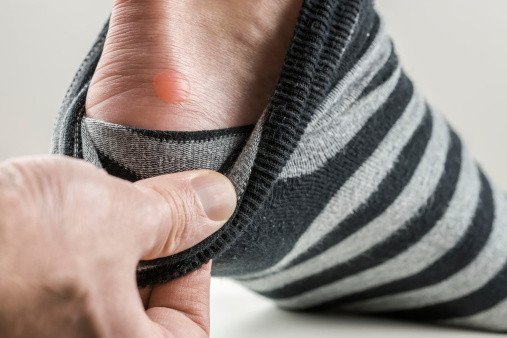Friction blisters
Medically reviewed by Drugs.com. Last updated on Nov 21, 2023.
What are Friction blisters?

A friction blister is a soft pocket of raised skin filled with clear fluid caused by irritation from continuous rubbing or pressure. Friction blisters usually occur on the feet, where tight or poor-fitting shoes can rub and irritate delicate toes and heels for long periods of time. This type of irritation causes minor damage to the skin and the tissue just beneath the skin, then fluid accumulates just beneath the outermost layer of skin. If the irritation is enough to damage small blood vessels, the blister also may contain blood, and is then called a blood blister.
|
|
Symptoms
A friction blister is a small pocket of puffy, raised skin containing clear fluid. It is usually painful when touched. A blister can appear anywhere.
Diagnosis
Blisters can be diagnosed by looking at them. In short, if it looks like a blister and feels like a blister, and if it's in a place that could have been irritated by pressure or rubbing, it likely is a blister.
Expected duration
Friction blisters typically drain on their own within days. A new layer of skin forms beneath the blister, and eventually the blistered skin peels away.
If pressure or friction continues in the same area, the blister may last two weeks or longer. Continued friction may rub away the delicate top skin layer, and the blister may break open, ooze fluid and run the risk of becoming infected or developing into a deeper wound. If the irritation is mild, the blister may heal despite continued irritation, and eventually a callus will form.
Prevention
The best way to prevent friction blisters is to wear shoes that fit your feet well, so that the shoe is not tight anywhere and does not slide up and down your heel when you walk. Wear socks with shoes to protect your feet and prevent irritation, and try to keep your feet dry. If another activity is causing blisters — for example, if learning to play golf is causing blisters on your hands — ask an instructor to point out other ways to perform the same activity in a nonirritating way, and take advantage of protective devices, such as gloves.
Treatment
Because blisters typically get better on their own in just a few days, generally no special treatment is required other than to keep the blisters clean and dry. Because the skin provides a natural protection against infection, a blister should be left intact if possible. Do not try to drain the blister or pierce or cut away the overlying skin. Try to avoid further irritation, or protect the blister with a sterile bandage if continued irritation is unavoidable. If the blister breaks on its own, gently wash the area with soap and water and gently pat dry. Try to keep the roof of the blister intact. Cover it with a bandage.
People with diabetes and people who cannot reach blisters easily (because of a physical disability or other ailment) may need to have their blisters evaluated by a foot specialist (podiatrist) or other health care professional. People with diabetes often have nerve or circulation problems that make it more difficult to recognize wounds, and that cause wounds to heal more slowly. In these people, a simple foot blister might go unrecognized and could become infected. People with diabetes need to care for their feet daily and examine them for sores or blisters.
When to call a professional
Widespread blistering, itchy blisters or blistering in a place that has not been exposed to rubbing or pressure should be evaluated by a physician. These are signs of an illness, not friction blisters.
For typical blisters, medical care is needed only if an infection develops. This is more likely to occur if the skin over the blister has been pierced, broken or popped. These types of blisters need to be watched for a few days to make sure they heal properly. See your doctor immediately if you think you have an infection, see significant redness, notice drainage that is not clear fluid or develop a fever. Also, seek professional help if the blister is so large or painful that walking or other activities become difficult.
People with diabetes who get blisters frequently or have blisters that don't seem to heal should see a health care professional.
Prognosis
Most blisters heal on their own in a few days. If there is continued pressure or friction to the area, it may take two weeks or longer for the blister to go away.
Additional info
American Diabetes Association
https://www.diabetes.org/
American Podiatric Medical Association (APMA)
https://www.apma.org/
Further information
Always consult your healthcare provider to ensure the information displayed on this page applies to your personal circumstances.

